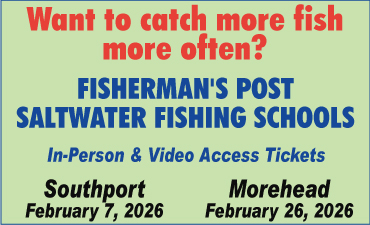Cape Fear On The Fly – Spanish Short Notice
In all kinds of fishing, the right conditions are everything. The right tide, the best moon phase, the optimum time of day, and especially wind and weather are all key factors in the success of any fishing trip.
Some of them we can control, but most of them we cannot. We can plan for the right tide or moon phase using prediction tables, but the weather is the weather and even the forecasts are only educated guesses.
And this brings me to the topic of the next installment of Cape Fear on the Fly: IT IS VERY HARD TO FLY FISH IN THE WIND!
If I had to pick one factor that poses the biggest challenge to any fly fisherman, it would have to be the wind. The wind will affect your ability to properly present the fly, and it will also affect the areas you are able to even fish.
As I chase redfish in the shallows most of the time, I am constantly hiding from the wind. I will always choose to fish a lee (out of the wind) shore as opposed to fishing a windward bank. It is easier to cast and present a fly to a target, and it is also easier to see fish in calmer waters.
When Gary and I decided last minute to try our hand at spanish mackerel with the fly rod, it had been a slick calm, no wind morning. However, when we finally got our act together just before lunch, the wind started to trickle in from the southeast.
As we headed out Masonboro Inlet, I got on the radio and begged for a little intel and was answered from a few generous local charter captains. Capt. Robbie Wolfe, of the famed “Whipsaw,” told us that the conditions earlier had been ideal to catch spanish on the fly, as the fish had been up on top jumping and feeding on the slick calm ocean. And Capt. Jot Owens said he had caught some spanish and bluefish earlier just north of the inlet.
I was hopeful the conditions would hold, as it would be ideal for Gary and I to catch some quick spanish on the fly. My plan was to run up the beach and look for birds or signs of fish feeding, and then get ahead of the schools and start chumming with frozen glass minnows to bring the fish close enough for an easy fly shot. Live “peanut pogies” work even better, but with our late start the glass minnows were a good second choice.
As we worked our way north we saw very few birds and no signs of surface feeding fish. All the while the wind was freshening up and our ideal conditions were rapidly deteriorating.
I called my friend Capt. Lynn Perry, of “Shearwater Charters,” and with his advice ran back south towards the inlet to find him in a tight circle steadily catching spanish on his planers. He informed me that the spanish were not on top as they had been that morning, and the choppy conditions would make it hard to see them regardless.
Gary and I changed plans and set up a drift that would take us from water depths in the mid-30 foot range on in to 20 feet. Once drifting we threw handfuls of glass minnows out and “blind cast” with identical setups and rigging that we used in the previous article covering bluefish.
After two drifts and one bluefish, we decided to throw in the towel and try again when the conditions were more conducive for sight-casting to spanish. Hopefully next time we can get on it while the conditions are still good and put some proven techniques to work.
Spanish mackerel may not be the most glamorous of species to catch on the fly, but they are absolutely a blast when you can coax them close to the boat with chum, live or otherwise, and watch them take your fly.
So next time you go spanish fishing, bring your fly rod and you may get an opportunity to cast to some speedy quarry and hone your fly fishing skills at the same time.
Thanks for reading, and Tight Loops!
Capt. Jon Huff
Capt. Jon Huff is owner operator of Circle H Charters, an inshore fly and light tackle guide service based out of Wrightsville Beach. Jon splits his time between running inshore charters, fishing offshore tournaments, and co-managing Intracoastal Angler. (910) 617-2619, www.circlehcharters.com





